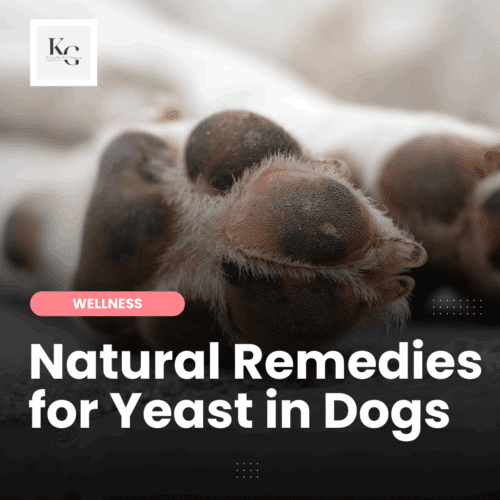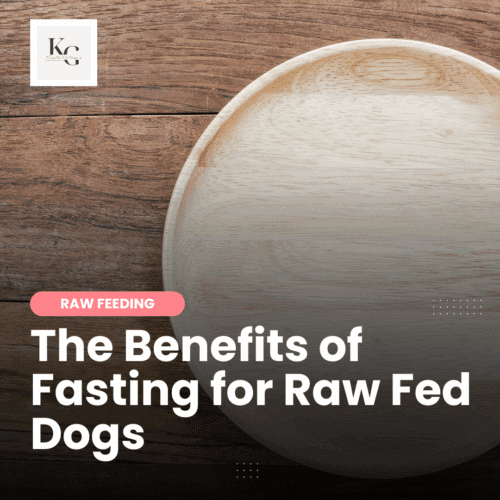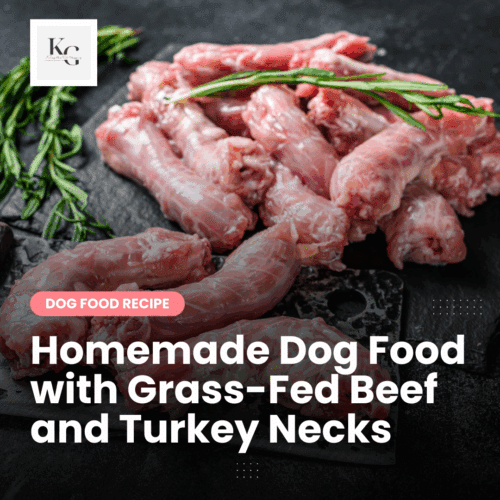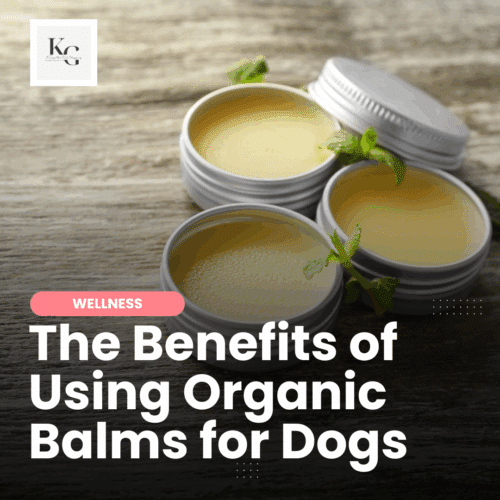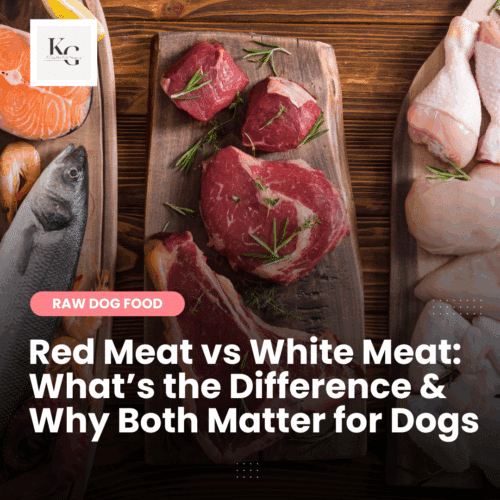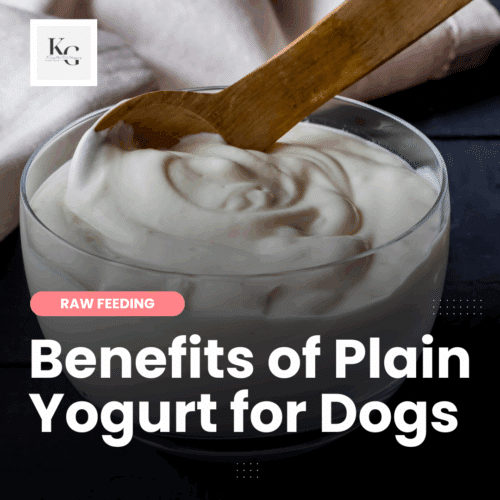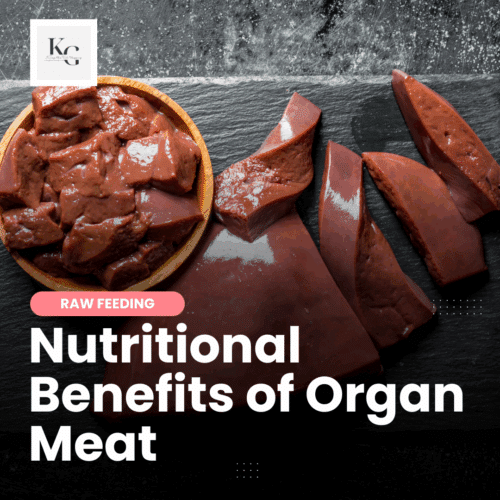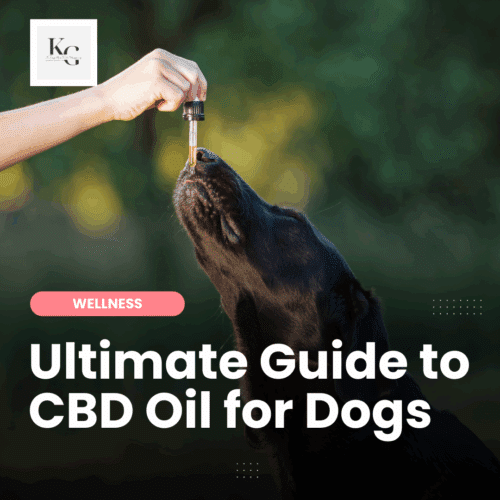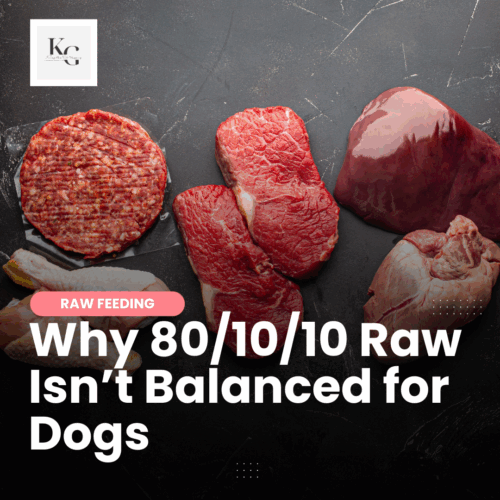Keep the Tail Wagging is supported by pet parents. I occasionally earn a commission (at no additional cost to you) when you click through an affiliate link to one of my favorite products. Thank you for your support. Read More
Raw feeding has become more mainstream, and with the growing number of raw food brands available, transitioning a dog to a raw diet, no matter their age, is effortless. There are several ways to transition a dog to a fresh food diet; I believe ‘cold turkey' is the easiest, and in this article, I share how you can make this change with little to no digestive upset.
Benefits of Raw Feeding for Dogs
Raw feeding is a diet that incorporates raw ingredients such as meat, bones, organs, vegetables, and some seeds and fruit. Although several are available, I follow a modified version of the BARF (biologically appropriate raw food) model of raw feeding. While there are varying opinions on raw feeding, proponents of this approach claim several potential benefits for dogs:
- Improved dental health: Chewing on raw meaty bones helps clean dogs' teeth and gums naturally, reducing plaque and tartar buildup and promoting healthier oral hygiene.
- Enhanced digestion: Raw food diets typically contain high-quality, whole ingredients that are minimally processed. This supports optimal digestion and nutrient absorption, potentially reducing digestive issues and improving stool quality.
- Increased energy and vitality: Raw diets are often rich in high-quality proteins, healthy fats, and essential nutrients. Dogs exhibit increased energy levels, improved coat condition, and overall vitality when fed a raw diet.
- Potential allergy relief: Some dogs with food sensitivities or allergies may benefit from a raw diet because it eliminates common allergens found in commercial dog food, such as grains, fillers, and artificial additives. However, each dog's response to diet can vary, so monitoring their individual sensitivities is important.
- Weight management: Raw food diets help maintain a healthy weight for dogs due to the balanced, nutrient-dense nature of the ingredients. It allows for greater control over food portions and promotes weight loss or maintenance as needed.
- Stronger immune system: Natural enzymes, vitamins, and minerals found in raw foods can support a dog's immune system, potentially reducing the risk of allergies, infections, and other health issues.
Common Raw Feeding Models
There are several different models or approaches to raw feeding for dogs. Here are some of the most common ones:
- Prey Model Raw (PMR): This model mimics a dog's natural diet in the wild and typically consists of whole prey or parts of prey animals. It focuses on feeding raw meat, bones, and organs in the proportions found in a prey animal, without any added fruits, vegetables, or grains. The approximate ratio is 80% muscle meat, 10% organs (with half being liver), and 10% edible bone. The emphasis is on sourcing high-quality, varied protein sources.
- BARF (Biologically Appropriate Raw Food): This model incorporates a wider variety of ingredients beyond whole prey. It includes raw meat, bones, organs, fruits, vegetables, and supplements. The percentage breakdown may vary, but it generally comprises about 60-80% muscle meat, 10% organs (with half being liver), 10% edible bone, and 10% fruits, vegetables, and other supplements.
- Whole Prey Model: This model involves feeding whole animals or carcasses, such as rabbits, quails, or small fish, to provide a complete and balanced diet. This approach aims to mimic a diet that includes all parts of an animal, including muscle meat, bones, organs, and fur or feathers.
- Frankenprey: This model is a variation of the Prey Model Raw where dog owners create a “frankenstein” prey by combining various parts of different animals to achieve a balanced diet. It involves sourcing different cuts of meat, bones, and organs from multiple species to approximate the nutrient composition of a whole prey animal.
- Commercial Raw Diets: Some dog owners opt for commercially prepared raw food diets. These are commercially prepared raw meals or mixes in pre-packaged forms, such as chubs, patties, nuggets, or medallions. These diets are formulated to meet the nutritional needs of dogs and often include a combination of meat, bones, organs, fruits, vegetables, and supplements.
It's important to note that no single model fits all dogs, and different dogs may have different nutritional needs. The model one chooses depends on the dog, what resources are available in their area, their budget, and more. To help determine which of these models is best, I suggest starting with commercial raw and working with a canine nutritionist (or researching) to uncover the best way forward.
DIY vs. Commercial Raw Diet
Regardless of which model you choose, you'll either feed DIY raw (do-it-yourself), commercial raw, or a combination of the two. There are pros and cons of both DIY and commercial raw:
- Pros of DIY raw feeding – dog owners control the ingredients, the sourcing, and the formulation. This is useful if a dog has food sensitivities or other health issues and is great for dog owners working with a budget.
- Cons of DIY raw feeding – not everyone is comfortable formulating their dog's diet. In some regions, the ingredients can be expensive or hard to find. For multi-dog homes, DIY raw feeding may require buying bulk, which requires dedicated freezers. And some DIY raw feeders invest in a meat grinder, pressure cooker, and dehydrator.
- Pros of commercial raw – someone else is responsible for sourcing, formulating, and packaging the raw meals. This is excellent for dog owners uncomfortable preparing raw, feeding a puppy, or lacking the resources to create a nutritionally complete homemade diet.
- Cons of commercial raw – premade raw can be more expensive than DIY. Some brands use synthetic vitamin mixes that are less bioavailable than real food or a sterilization process that decreases (or eliminates) the healthy living enzymes and bacteria in raw food.
Transitioning to a Raw Diet
Whenever a new dog joins our family, I transition them cold turkey – the first meal they have in our home is a raw meal.
Transitioning puppies to raw: I transition puppies to a commercial raw diet formulated for all life stages. I find it helpful to contact the brand directly to inquire about what additional foods (bone, fat) are needed when feeding puppies. Puppies are growing rapidly, requiring more food that is balanced daily rather than over time.
Transitioning adult dogs to raw: I transition adult dogs to either a commercial or DIY raw diet, depending on their individual needs. For example, if an adult dog has a history of digestive issues, is a picky eater, or has a health condition, I may slow the transition down or fast the dog for 24 hours before switching to raw.
Feeding a hybrid diet: Feeding fully raw isn't feasible for all dog owners. In this case, feeding a 1/2 kibble and 1/2 raw diet might be more manageable. When I was new to raw feeding, I started with a hybrid diet and fed raw in the morning and kibble in the evening. Mixing raw and kibble in one meal isn't always recommended because it leads to digestive upset in some dogs (but not all).
Feeding Raw Meaty Bones
When introducing dogs to raw meaty bones, I believe starting with easier bones like poultry necks and feet is best. With some dogs, I'll hold on to the bone to ensure they don't try to swallow it whole, and I monitor my dogs when they're eating raw bones.
I never feed cooked bones; this includes smoked, baked, or roasted.
What to Expect When Transitioning to Raw
Dogs new to raw feeding can experience loose stool or diarrhea as they transition. Some dog owners report a detox period that includes mucus-covered stool, increased shedding, tear stains, doggy odor, and increased ear wax. This is temporary as the body adjusts to a healthier diet and sheds the accumulation of toxins from the system. And not all dogs experience a detox; I didn't witness this with any of my dogs.
Notes for new raw feeders…
- Heart and liver are rich, and feeding too much, especially to a puppy, can lead to explosive diarrhea. Dog owners planning to provide DIY raw should start small with organ meat and build-up.
- Puppies eat more than adult dogs due to their rapid growth; I feed 10% of a puppy's body weight, weighing them weekly to avoid overfeeding.
- Alternating proteins is important; this practice provides a variety of amino acids and other nutrients to your dog, better meeting a dog's nutritional needs. Variety also prevents boredom at mealtime and food sensitivities. It's okay to feed various brands – if it works for your dog.
- Supplementation isn't necessary beyond a digestive supplement or fiber, which may help ease the transition. The best digestive supplements for dogs new to raw feeding are:
Raw Diet Feeding Guidelines
Feeding adult dogs 2-3% of their body weight is advisable. An online raw feeding calculator is the easiest way to determine how much food to feed your dog. Or working with a canine nutritionist.
With my dogs, I start with 3% with active adult dogs and 2% with sedentary adult dogs. I then adjust up or down based on how the dog responds to the diet. For example, if a dog gains weight and this isn't the goal, I'll reduce the amount I feed. With puppies, I begin with 10% of their current body weight and adjust as they age.
Raw Diet Feeding Guidelines for Puppies
The following raw feeding guidelines for puppies explain how much to feed at different ages during a puppy's first year. Every dog is unique, making it crucial to adjust how much you provide based on your dog.
- 2 – 4 months: 8-10% of their body weight
- 4 – 6 months: 6-8% of their body weight
- 6 – 8 months: 4-6% of their body weight
- 8 – 12 months: 3-4% of their body weight
Don't Complicate Raw Feeding
You may have been told about the importance of balancing the macro/micronutrients, food energetics, and supplementation. While these are important, they aren't crucial for new raw feeders. You can start feeding raw while simultaneously educating yourself about canine nutrition. Books and courses are available online to help you better understand how to feed your dog.
A Raw Diet Isn't For Everyone
Some dogs need time to adjust to their new diet; others won't be a good fit and might do better on a cooked, freeze-dried, or dehydrated diet. It's essential to exercise patience and remain open to new information on feeding raw. Transitioning to commercial raw gives dog owners time to figure out their budget, secure sourcing, and better understand how to formulate a diet that meets their dog's nutritional needs.
If raw feeding isn't for you, please don't feel ashamed or embarrassed. Feed your dog the best food you can afford, and if the best is kibble, add fresh food to your dog's diet. Examples include:
- DIY bone broth
- Raw goat's milk or kefir
- DIY vegetable mix
- gently cooked ground meat (beef, chicken, turkey, lamb)
- canned fish (not smoked): sardines (in water, with no salt added), pink salmon, mackerel, oysters



